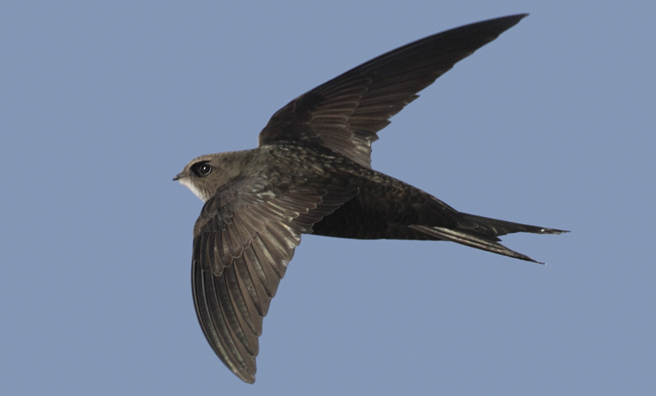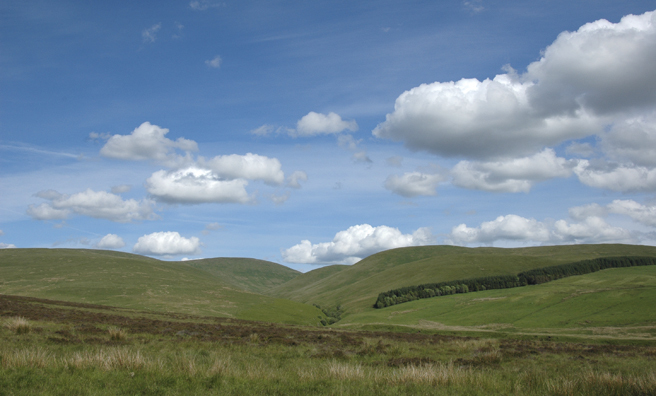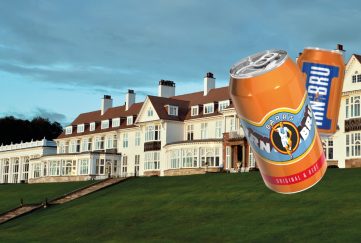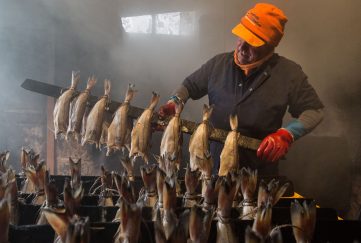A Swift Encounter

The swifts came late. If you remember April 2012 at all you will remember it with a shudder.
North-easterly winds, rain, sleet and snow, and spring hiding its head under its wing, or more likely in the case of the swifts, strafing the insect hordes above France’s Massif Central while they waited for May to get its act together in Scotland. It did, all of a sudden, and the temperature hit 25 degrees in Balquhidder. Then the swifts arrived, more than two weeks late, on May 22.
It was tempting to assume that just because they were late in Stirling and Callander, which is where I have been accustomed to greet them around the end of the first week of May these last 30 years or so, that they were late everywhere. Then I had a letter from my friend David Craig who lives just south of the Lake District, with a PS to the effect that his swifts arrived on May 7, “only a day late”.
We seem to enjoy each other’s company
Swifts are real people birds. We seem to enjoy each other’s company. Swifts are one of those species by which we mark the turn of the seasons, their arrivals and their departures.
I remember with a bit of a thrill that first shrill screech of two birds above suburban Stirling rooftops that late May day, for they are among my own favourites and I had begun to wonder darkly if we might have a swift-less spring and what ill that might bode.
And now as August dawns, I’m wondering how many (how few) days we have left to enjoy them.
The moment the season’s new birds fledge, they migrate
The numbers have already fallen among the local colonies, because the moment the season’s new birds fledge, they migrate. They don’t hang around to learn how to do things on their parents’ coat-tails, or to ask the way. They tumble from the nest with their powers of flight and their survival instincts apparently already honed; they just go and seem to know where they are going and how to get there.
Swifts are a far-flung tribe – there are 65 species in the world, of which we have just the one, the prosaically named common swift, although it is not just as common as it once was. There are, of course, the once-in-a-blue-moon, fly-by-night, where-the-hell-am-I visits from a lost pallid swift, a little swift, or an alpine swift. The most incongruous of all of these is the alpine swift, a denizen of the high Swiss Alps, which prompted much ornithologist head-scratching when it turned up dead in 1979 in Portobello High Street.
There’s a diminishing supply of nest sites
The most likely reason why the common swift is now less common in our midst has to do with a diminishing supply of nest sites, which in turn has to do with the way we construct new buildings and for that matter, the way we restore and repair old ones. The swift evolved from a bird of mountains, cliffs and trees (especially Scots pines), into a nester among buildings. So they became familiar in the heart of our towns and cities, tearing across the squares of sky above our streets, their raised voices demanding that we look up to admire their aerobatics.
They love to nest in the spaces inside our roofs and under our eaves, the nooks and crannies of our architecture, until that is, we started to build houses without eaves, without nooks, without crannies, and became over-zealous (from the swifts’ point of view) at sealing and smoothing the rough edges of our old buildings. One way and another, our determination to build heat-efficiency into our homes has closed the door on swifts. It has become something of a problem in so many European countries that there is a website, www.concernforswifts.com, which should be compulsory reading for architects and builders and you, if you’re planning to employ one in the near future.
They have never totally lost the wilderness habit
What may happen, what may already be happening, is that swifts will un-evolve and head in increasing numbers back to the hills and the cliff and the pinewoods, for they have never totally lost the wilderness habit, and seem especially partial to sea cliffs, although they’re reluctant islanders. They breed on the mainland as far north as Wick and Thurso, but not apparently in Orkney or Shetland, which is strange, because I once watched a pair service their nest under the roof of the hotel where I was staying in Norway, so latitude can’t be the problem.
Seton Gordon noted in Afoot in Wild Places, the presence of a single bird on Hasker, west of the Uists, but would confidently write in The Land of the Hills and Glens that “the swift is absent from the islands”. Today, there are established colonies in Iona Abbey and on Arran, and occasional birds have been known to turn up (quite possibly on foraging trips) on St Kilda, but there again, there was that alpine swift in Portobello so it seems that almost anything is possible.
I met alpine swifts on the summit of Schilthorn
I met alpine swifts in the wild once, on the summit on the Schilthorn in the Swiss Alps, and at about 9000 feet, where they were keeping the company of alpine choughs. They’re huge – by swift standards, that is – and hurtle around the place like boomerangs.
I also once met a flock of about 50 swifts on the highest reaches of the Cairngorms plateau, and have had several encounters there with smaller groups and individuals. And somewhere or other (I can no longer pinpoint the source) I read of an encounter that Seton Gordon had there with a single bird late in the winter that led him to speculate that it might have hibernated in a cave or a particularly sheltered cliff overhang, and while there is no scientific evidence of any kind to support his idea, he was nobody’s fool in the matter of Cairngorms wildlife, and would never have posted such a notion so publicly without giving it consideration.
One of their most endearing traits from the point of view of a spectating fan is their apparent exuberance in assembling a huge flock and appearing out of thin air to transform a placid landscape. It happened to me, 2000 feet up in the Ochil Hills, on the broad pow of Blairdennon above the head of Glen Tye and Sheriffmuir, the hills wearing that lush August green that looks somehow wrong in a Scottish context, the sky a deep, dark blue with massed snowdrifts of cumulus towering above the plateau and almost no wind to move them. It was warm and all-but-still, and layered with that particularly profound species of hill calm that can envelop just such an August noon.
Then the swifts came. I saw them a mile off in the south, somewhere above Colsnaur, but so vivid was the light that it magnified the least movement and electrified it. Suddenly there was a loosely formed dark cloud hundreds of feet up and bearing down on the hill where I stood, binoculars raised, trying to make sense of its advance. Then I heard it and knew at once what it meant.
The swifts arrived and smothered the hilltop in chaos
The birds arrived and smothered the hilltop in chaos, so dense and so loud, and so (in a way not easy to define) disconcerting, that trying to follow the flight of a single bird for more than a few seconds was frankly impossible. The flock ranged in altitude between a few inches above ground level and I would guess three or four hundred feet up, and having reached Blairdennon it appeared to reach a collective understanding of a destination. For fully half an hour, the birds charged through Blairdennon’s airspace in a raucous havoc of perpetual motion.
To be in the midst of it was to be curiously diminished by birds each not much bigger than my hand, but in these numbers – perhaps 500 of them – the most potent image that lingers was of meeting a single unassailable creature the size of the flock.
Then quite suddenly they were gone. The flock did not charge away across the wide Ochils plateau so that I could watch its progress, but rather seemed to dematerialise, to fall away through the air like flour through a sieve, away down the hillsides, beneath my line of sight. I felt as if the flock had picked me out from afar and condescended to grace my day with ambassadorial presence.
- Jim Crumley
- Glen Tye with Blairdennon on the skyline
- Swifts and humans make ideal company
Swift facts
- Swifts are superb in the air and even sleep on the wing
- They appear black in the sky but are actually brown in colour
- They have short, forked tails
- There are 87,000 breeding pairs in Britain which can be seen between May and August







